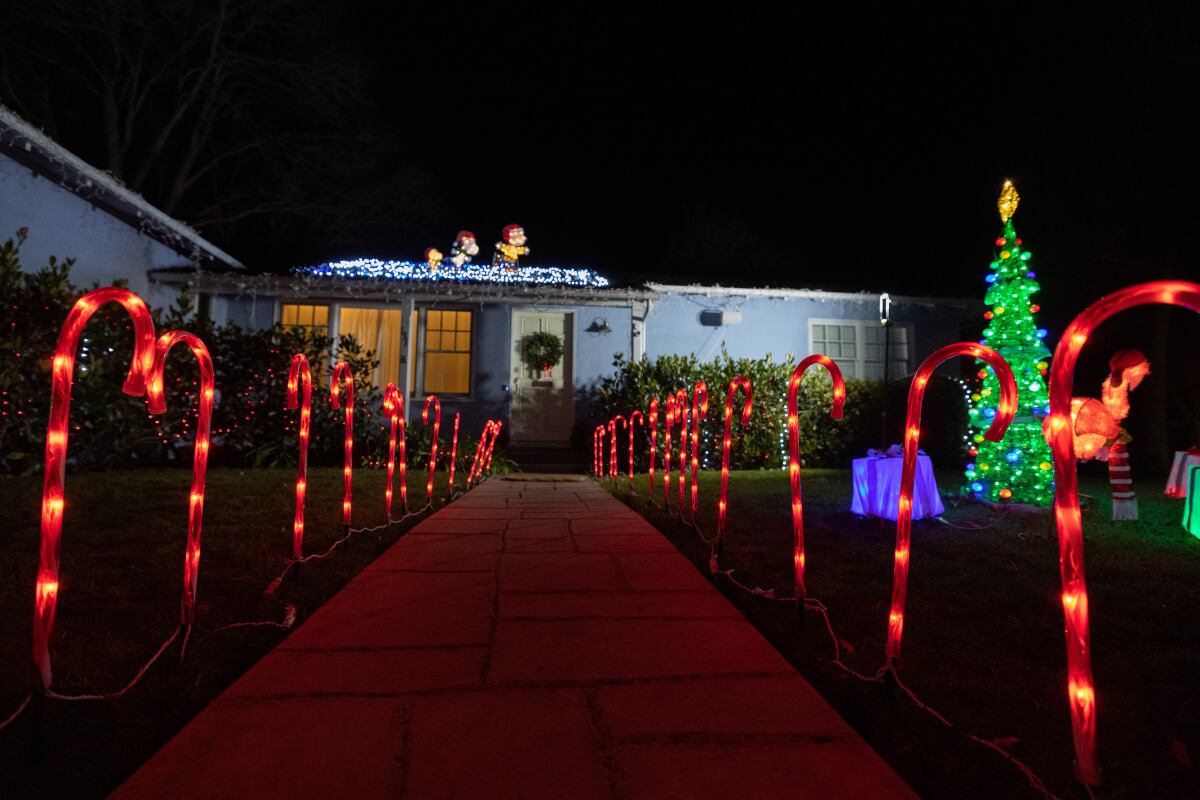This Silicon Valley executive couldn’t get a job because he didn’t have a resume.

PALO ALTO — On a chilly December evening, 54-year-old engineer Mark Robins opened a laptop inside his son’s room to demonstrate the software he uses to control the 10,000 lights that adorn his house and yard. They illuminate an assortment of candy canes, gift-wrapped boxes and animals, including a flamingo, an owl, a reindeer and a small dog that resembles his elderly mutt, Oscar. A button at the front of the yard invites passersby to synchronize the lights to one of 25 Christmas, pop and rock tunes.
Robins pulled up the Earth, Wind & Fire song “September,” which is connected to 16 “channels” tied to strings of lights around his house and yard. For every minute of music, it takes an hour to program exactly how he wants the lights to flash.
“All these little symbols on here are telling that light to go on at that time in the song,” Robins said. “I like building things, and then if you can build something that other people can appreciate and enjoy and get some happiness out of, that’s even better.”
Inspired by a Christmas lights display he saw at Walt Disney World years ago, Robins thought he would sprinkle a little pixie dust on his Silicon Valley neighborhood. And the reward was more than just holiday cheer — it helped land him a senior job at a high-profile streaming company.
“I wasn’t trying to get a job when I did this,” Robins said. “But, you know, serendipitous things happen all the time. In a way, it’s sort of like making your own luck, right?”
Homeowners nationwide have spent big money on holiday displays during the COVID-19 pandemic.
Kids press the play button on the red table to start the musical light show as Mark Robins, left, checks on the computer program in Palo Alto.
(Paul Kuroda / For The Times)
This year, consumers are expected to spend $67.10 per person on holiday decorations, up about $4 from 2021, according to the National Retail Federation trade group. A search on YouTube shows a host of homes with elaborate synchronization, including one in Riverside where music is piped through a radio frequency that viewers can tune into on their cars.
Robins spent about $3,000 on his light show, which did more than impress his neighbors.
In 2020, Robins — then head of Intel’s corporate A.I. strategy — wrote in his family’s Christmas letter that he was automating his home in Palo Alto with a smart irrigation system, thermostat and grill. At the same time, his light show was becoming more popular — that year it won the city’s people’s choice award, beating former Yahoo Chief Executive Marissa Mayer, Robins said.
The light show and letter caught the attention of Anthony Wood, chief executive of Roku, who lives a block away.
The San Jose-based company is known for its devices and operating software that connect TVs to many streaming services. Wood sent an email to Robins, complimenting him on his light show and mentioned that Roku had an ambitious smart home project underway and that the company was looking for somebody to run it. Was Robins interested?

Musically synced holiday lights at Mark Robins home in Palo Alto, Calif.
(Paul Kuroda / For The Times)
“He kind of put those two things together and saw my kind of passion for that space,” Robins said.
Robins, who was already a Roku user, was game to meet for coffee. The job would be leading the company’s new smart home division, launching a whole new category of items that Roku had not sold before, including smart light bulbs, security cameras and doorbells.
A risky bet for some, but not for Robins, who previously had co-founded and led a startup that was later sold.

Musically synced holiday lights at Mark Robins’ home in Palo Alto.
(Paul Kuroda / For The Times)
“Building companies, building businesses, creating something from nothing or very little is really exciting for me,” Robins said.
After a rigorous job interview process, he joined Roku in May 2021, overseeing a team of hundreds of employees worldwide. Roku launched its new smart home products in October at Walmart.
“It was clear the dedication, passion and creativity Mark displayed with his light show, along with his impressive career résumé, would be a great addition to Roku’s leadership team,” said Mustafa Ozgen, the company’s president of devices, who is Robins’ boss.
Robins says his inspiration for the light show came after a memorable visit to Walt Disney World in 2013, when he, his wife, Kim, and their three kids watched the Osborne Family Spectacle of Dancing Lights.
The show, which synced to music and millions of lights across several buildings, came to Disney World after the company made a deal with Jennings Osborne, whose light display in Little Rock, Ark., drew so much traffic that he was sued by his neighbors.
Robins asked his kids if they would like to see a light show like that at their house. They screamed, “Yes!”
It took him a few years, but in 2017, Robins brought his first light show to Palo Alto.
His eldest daughter, Gillian, turned to him and said, “Wow, you said you were going to do it and you did it” — a moment Robins cherishes.
“So I guess there is some kind of life lesson in there,” he said.
Setting up the show is an elaborate process.
Three weeks before Thanksgiving, Robins gets to work, unraveling strings of lights out of six plastic containers and spending 12 hours over a few weekends setting everything up. His wife holds a ladder for Robins as he climbs the roof to mount the ice skating Charlie Brown and other Peanuts characters. He also gets assistance from his daughter Krista, who wraps strings of lights around one of the big trees in the yard.

Musically synced holiday lights at Mark Robins’ home in Palo Alto.
(Paul Kuroda / For The Times)
The system is so complex that he needs a Google doc to map plugs and
extension cords that link 16 strands of lights and decorations to a main controller box outside his house. An ethernet cable links the controller to a designated laptop inside the house that runs the light show.
A short cable from the laptop’s headphone jack runs to a nearby amplifier, and cables from the amp are connected to two speakers hanging outside under the eaves. Power is fed to the amp by a Roku Outdoor Smart Plug that sits by the sidewalk, where a lighted-up sign invites passersby to push a button on the plug to start the show in up to 15-minute increments.
On a recent weeknight, neighbor Lisbeth Winarsky strolled by Robins’ house with her husband and dog Stella, and said, “Oh, let’s push the button.” Red, white and green lights flashed as Mariah Carey sang, “I don’t want a lot of Christmas, there is just one thing I need…”
As Winarsky listened to the music, a man walked by the light show. Winarsky introduced herself, and the two remarked how the man’s name was similar to her father’s name.
“I think that’s one of the most valuable things you can do with your civic life is to bring people together and create a sense of community, so I’m always very grateful to them for doing this,” 70-year-old Winarsky said.
The joy of seeing people push the button extends inside the Robins’ home too. Sometimes, when family members are watching a movie on their TV, Robins’ mom visiting from New Jersey will exclaim, “We got a pusher!”
Over the years, he’s added more songs to the mix. When he hears a Christmas song on the radio, he imagines how he’d program it to the dancing lights in his head. Sometimes after a late-night programming session, he’ll excitedly dash outside at 1 a.m. and run a demo (with the music volume low) to check on his work.
Sometimes he marvels at how his hobby turned into a job.
“I would encourage people who have a hobby that potentially others can appreciate to make an effort to get it in front of as many people as you can,” he said. “And who knows what will happen?”




